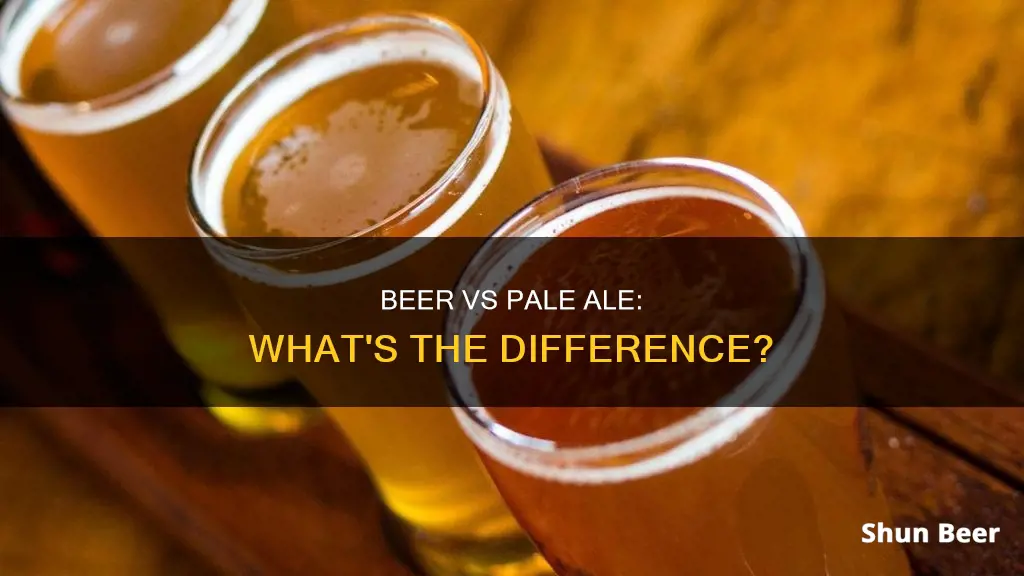
Beer and ale are both types of fermented alcoholic drinks made with grains, water, yeast and hops. Beer is a broader term that includes various styles and flavours, while ale is a specific type of beer made with a different kind of yeast and fermented at a different temperature. Ales are brewed with top-fermenting yeast strains and fermented at warmer temperatures than lagers, resulting in a fruitier, more complex flavour profile. Pale ales are a popular style of beer that is hop-forward with a malty flavour, a golden-to-amber colour, and moderate strength. They are brewed with pale malt and ale yeast, bridging the gap between dark stouts and light lagers.
What You'll Learn
- Pale ales are a bridge between light lagers and dark stouts
- IPAs are a subcategory of pale ales, with more hops and higher ABV
- Pale ales were first brewed in England in the early 1700s
- Pale ales have a more balanced flavour, with more malt and less bitterness
- Pale ales are best served at cellar temperature, between 50 and 60°F

Pale ales are a bridge between light lagers and dark stouts
Beer is broadly categorised into two types: lager and ale. Ales are created through top fermentation, where yeast ferments at warmer temperatures and settles at the top of the beer. Lagers, on the other hand, are fermented with bottom-fermenting yeast at colder temperatures.
Pale ales are a type of beer that falls under the broader category of ales. They are characterised by their hop-forward, malty flavour, golden to amber colour, and moderate strength. Originating in England in the early 1700s, pale ales were crafted as an alternative to standard dark beers. Brewers developed techniques to control malt intensity, resulting in a lighter beer with a milder palate.
Pale ales occupy a unique position in the beer spectrum, serving as a bridge between light lagers and dark stouts. They offer a flavourful yet not overly heavy drinking experience, making them accessible to a wide range of drinkers. The balance of characteristics from both ends of the beer spectrum is what makes pale ales so appealing.
The versatility of pale ales is further enhanced by the various styles that have emerged, such as the American Pale Ale, British Pale Ale, American Amber Ale, and Blonde Pale Ale. These variations allow drinkers to explore different flavour profiles while still enjoying the signature qualities of a pale ale.
In conclusion, pale ales occupy a distinctive niche in the beer world, blending the qualities of light lagers and dark stouts to create a flavourful and approachable drinking experience. With their rich history, diverse styles, and balanced characteristics, pale ales have become a popular choice for beer enthusiasts worldwide.
Alcohol Content in Beer: State-by-State Differences
You may want to see also

IPAs are a subcategory of pale ales, with more hops and higher ABV
India Pale Ales (IPAs) are a type of pale ale, but with some key differences. Both beers are brewed with a focus on hops, but IPAs tend to be more hop-heavy, resulting in a stronger, more bitter taste. Pale ales, on the other hand, have a more balanced flavour profile, with a more subtle bitterness that comes from the hops.
IPAs were created in the 1800s as a variation of the traditional English bitter ale. The term "India Pale Ale" was first used in the 1820s when British brewers created a stronger and more heavily hopped version of their pale ales that could survive the long journey to India. The extra hops acted as a preservative, increasing the beer's alcohol content and flavour intensity while extending its shelf life.
Today, IPAs typically have a higher alcohol by volume (ABV) than pale ales. Pale ales usually range from 4-6% ABV, while IPAs tend to be between 6-7% ABV. However, there are variations within each style, and some IPAs can reach as high as 12-14% ABV in the case of Double IPAs.
In terms of flavour, IPAs are known for their fruity aromas and flavours, often featuring notes of lemons, oranges, and grapefruits. Pale ales, on the other hand, tend to have more bread-like and nutty notes, with a touch of caramel. While IPAs showcase stronger hop flavours, pale ales offer a more balanced experience, highlighting both the hops and the malt.
While IPAs and pale ales share a common heritage and similar brewing processes, the key differences lie in the intensity of the hops, the ABV, and the resulting flavour profiles. IPAs are ideal for those who enjoy bold, fruity flavours and a stronger beer, while pale ales provide a lighter, more delicate hop experience.
Beers Around the World: A Guide to Varieties
You may want to see also

Pale ales were first brewed in England in the early 1700s
The rise of pale ales as a distinct style of beer began in the late 18th century and continued into the 1800s. Before the emergence of pale ales, beers in England were mostly deep brown or black in colour, and as malting technology improved, brewers were able to better control the intensity of the roast and flavour, resulting in lighter beers. Pale ales were generally amber or copper in colour and could include styles such as English Bitter, India Pale Ale, and Belgian Pale Ale.
The area of Burton-on-Trent in England became known for its pale ales due to the presence of water rich in calcium sulfate, which encouraged the presence of hop flavour in lighter-coloured beers. The original pale ales created in Burton-on-Trent were brewed with the local hard water and more hops than usual, typically Fuggles, Kent Goldings, and Northern Brewer varieties.
The expression "bitter" became synonymous with "pale ale" by 1830, as breweries used the term "pale ales" to describe their beers, while customers referred to the same beers as "bitters". Customers may have used the term "bitter" to differentiate these pale ales from other less noticeably hopped beers such as porters and milds.
Beer Size Matters: How Larger Brews Differ
You may want to see also

Pale ales have a more balanced flavour, with more malt and less bitterness
The difference between beer and pale ale can be confusing, especially when comparing pale ales to IPAs (India Pale Ales). Beer is a broader term that encompasses various styles and flavours, while ale is a specific type of beer made with a different kind of yeast and fermented at a different temperature.
Pale ales are a popular style of beer with a hop-forward, malty flavour, a golden to amber colour, and moderate strength. They were first created in England in the early 1700s as an alternative to standard dark beers. English brewers became skilled at controlling the malt intensity, crafting a lighter beer with a more mild palate. Pale ales are a bridge between dark stouts and light lagers, with a full flavour that is not too heavy, making them very approachable.
When comparing pale ales to IPAs, it is important to note that IPAs fall under the umbrella of pale ales. However, IPAs tend to be more hop-heavy, have a higher alcohol content, and taste more bitter than pale ales. Pale ales, on the other hand, have a more balanced flavour, with more malt and less bitterness. They also have a lower alcohol content, typically ranging from 4-6% ABV, making them a lighter drinking experience.
The American Pale Ale (APA), created in the 1980s, dials down the maltiness and uses more aggressive North American hops, resulting in a spicy brew with citrus and tropical fruit accents. British pale ales, also known as English-style pale ales, have a more understated, pleasant flavour with a malty profile, woody or lightly floral hops, and some fruity notes.
In summary, pale ales offer a more balanced flavour profile compared to IPAs, with a stronger malt presence and less bitterness. This makes them an excellent choice for those seeking a lighter, more delicate hop experience.
Pilsner vs Lager Beer: What's the Difference?
You may want to see also

Pale ales are best served at cellar temperature, between 50 and 60°F
Pale ales are a popular style of beer, known for their hoppy flavour, malty notes, and golden to amber colour. They are usually medium-bodied and not too strong, making them a great option for those who prefer a more delicate hop experience. The style includes malty English ales, balanced American brews, Belgian session ales, and hoppy IPAs.
When it comes to serving pale ales, temperature plays a crucial role in enhancing their flavour and aroma. Most pale ales are best served at cellar temperature, between 50 and 60°F (10-16°C). This slightly warmer temperature range ensures that the delicate flavours and aromas of the pale ale are not suppressed. Warmth tends to make flavours more perceptible, while cold temperatures can mask them. By serving pale ales within this temperature range, you'll allow the chemical compounds responsible for their unique aromas and flavours to be properly activated.
At the lower end of this temperature range, around 50-55°F (10-13°C), you'll find Belgian ales, sour ales, Bocks, English bitters, and milds, as well as Scottish ales. These styles benefit from being just a bit warmer than the typical mass-market light lagers served at 35-40°F (2-4°C) or the slightly warmer Czech and German Pilsners, Munich Helles, wheat beers, and Kölsch served at 40-45°F (4-7°C).
Some IPAs and American pale ales are best served just a bit colder than traditional pale ales, at 45-50°F (7-10°C). However, it's important not to serve them too cold, as this can mute their flavours and make them seem thin and tasteless. As a general rule, the hoppier the beer, the warmer it should be served.
When in doubt, remember that light-bodied and low-alcohol beers are typically served colder, while full-bodied and high-alcohol beers are served warmer. However, the ideal serving temperature also depends on the specific style, brewing process, and tradition.
By serving pale ales at the optimal temperature, you'll be able to fully appreciate their complex flavours and aromas, making for a truly enjoyable drinking experience.
Exploring the Diverse Flavors of Beer: A Tasty Adventure
You may want to see also
Frequently asked questions
Beer is a broader term that encompasses various styles and flavours. Ale is a specific type of beer made with a different kind of yeast and fermented at a different temperature. Pale ales are a popular style of beer with a hop-forward, malty flavour and a golden to amber colour.
Lager is made with bottom-fermenting yeast and fermented at cooler temperatures than pale ale, resulting in a smoother, crisper flavour profile. Pale ales are brewed with top-fermenting yeast and fermented at warmer temperatures, giving them a fruitier, more complex flavour.
IPA stands for India Pale Ale. IPAs are a subcategory of pale ales but tend to be more bitter, hop-heavy, and higher in ABV. Pale ales have a more balanced flavour and a lower ABV.
Popular pale ales include American Pale Ale, British Pale Ale, American Amber Ale, and Blonde Pale Ale.







